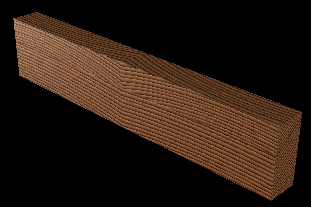
Simulates wood by projecting a 2D pattern. This pattern consists of concentric ring layers defined by veins and filler. When you map the Wood texture to a surface, the surface seems to be carved out of wood. When you map it to several surfaces, they seem to be carved from a single block of wood.
Find this texture in the Create tab. To apply this texture as a texture map, see Map a 2D or 3D texture.
- There are four Wood attributes that are frame constant, meaning that mapping them with textures or other nodes that produce different values from point to point may lead to unpredictable results. These attributes are: Grain Spacing, Layer Size, Randomness, and Age. You can key all of these attributes to make their appearance change over time in an animation sequence.
- If you use the Wood texture as a bump map, lower the Grain Contrast setting to reduce the potential for texture artifacts during animation.
- Filler Color
-
The color of the space between veins. The vein color diffuses into the filler color. Double-click the color bar to choose a different color from the Color Chooser.
- Vein Color
-
The vein color of the wood. The vein color diffuses into the filler color. Double-click the color bar to choose a different color from the Color Chooser.
- Vein Spread
-
The amount of vein color that diffuses into the filler color. The valid range is 0 to infinity. The slider range is 0 to 3. The default is 0.25.
- Layer Size
-
The average thickness of each layer or ring. The valid range is 0 to infinity. The slider range is 0 to 0.5. The default is 0.02. (The thickness of individual layers or rings is also influenced by the Randomness and Age values.)
- Randomness
-
Randomizes the thickness of individual layers or rings. The range is 0 to 1. The default is 0.5.
- Age
-
The age of the wood (in years). This value determines the total number of layers or rings in the texture, and influences the relative thickness of central and outer layers. The valid range is 0 to infinity. The slider range is 0 to 100. The default is 20.
- Grain Color
-
The color of the random grain in the wood.
- Grain Contrast
-
Controls the amount of Grain Color that diffuses into the surrounding wood color. The range is 0 to 1. The default value is 1.
- Grain Spacing
-
The average distance between grain spots. The range is 0.002 to 0.1. The default value is 0.01.
- Center
-
The location of the center of the texture’s concentric rings in the U and V directions. The range is -1 to 2. The default values are 0.5 and -0.5.
Tip:Do not set the Center values less than -3 or greater than 3.
Noise Attributes (Wood)
The Wood texture creates a 3D texture by projecting a 2D pattern. The Noise Attributes control the randomization (using fractal noise) of the texture in the direction the pattern is projected. Select from the following:
- Amplitude X, Amplitude Y
-
An average scaling factor applied to all values in the fractal noise in the texture’s X and Y directions. The valid range is 0 to infinity. The range is 0 (no noise) to 1 (strong noise). The default value is 0.1.
Tip:The Wood texture renders faster if the Amplitude X and Amplitude Y values are both 0.
- Ratio
-
Controls the fractal noise frequency. The range is 0 (low frequency) to 1 (high frequency). The default is 0.35.
- Ripples
-
Determines the texture’s waviness in the X, Y, and Z directions. The values represent the frequency scale of the fractal used to generate the texture. The range is 0 to 20. The default is 1.
- Depth
-
The minimum and maximum number of iterations used to calculate the texture pattern. This parameter controls how fine grained the texture is. The range is 0 to 25. The default values are 0 and 20.
